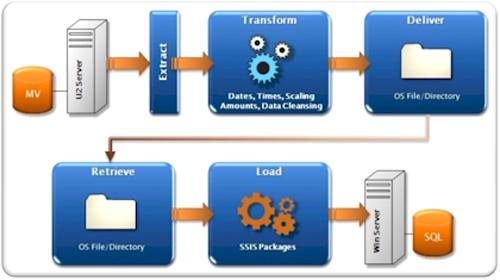
The information contained in this guide outlines the steps required to move a MultiValue (MV) file to Microsoft SQL server using Kore's SQL Accelerator and Kourier products.
Often times, the initial SQL database being populated from the MultiValue database is considered a staging database and is not used for reporting. Instead, data from the Staging Database is moved via trigger or other means to a star schema database which is then used to build OLAP (On-line Analytical Processing) cubes. This guide is focused on the process of populating the Staging Database (diagrammed below). It is common to produce both operational and analytical reporting directly from the staging database.

tipWidgetTipBefore getting started, your team should conduct a planning meeting to determine your specific strategy and conventions for the data warehouse project.
We suggest the following directory structure to organize the various files used in this process:
|
Directory |
Usage |
|
...\ODS\Inbox |
Contains the datasets to be imported by the SQL SSIS packages. This directory must be visible to both your MV server and the SQL server. |
|
...\ODS\Logs |
Contains the logs files generated by each SSIS package. |
|
...\ODS\Config |
Contains the configuration files used by the Kore's SQL Accelerator. |
|
...\ODS\Packages |
Contains the SSIS packages created by Kore's SQL Accelerator. |
|
...\ODS\Schema |
Contains schema information generated by the quick-start tools. |
Before starting to move data from the MV environment, the Quick Start Workbench Configuration must be defined. This page may be accessed under the Administration menu.
The process of moving data from each file in the nested relational model of a MultiValue database to the 1st normal form model of SQL consists of 8 primary steps:
Once these steps have been performed, the data will be available in SQL Server for reporting or analysis.
Duplicate primary keys caused by the fact that MV databases are case-sensitive and SQL tables (by default) is case-insensitive.
Data truncation caused by the data in MV database exceeding the defined length of a column in the SQL table.
Wrong data types.
noteWidgetNoteThis step is required only if the Autorun SSIS Packages option is not set in the Service definitions.
Once you have created and tested all the individual SSIS packages create one master SSID package that runs all the individual packages. This allows you to schedule all jobs as a single unit. For a master package, make sure to limit the maximum number of tasks executed in parallel to 1. This setting can be found on the General tab in the package properties.